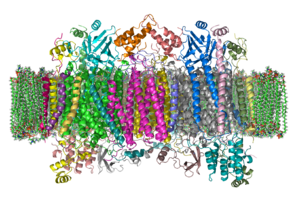
Back سيتوكروم سي أكسيداز Arabic Citocrom c oxidasa Catalan Cytochrom c oxidáza Czech Cytochrom-c-Oxidase German Citocromo c oxidasa Spanish سیتوکروم اکسیداز سی Persian Cytochrome c oxydase French Citocromo c oxidase Galician Citokróm c-oxidáz Hungarian Sitokrom c oksidase ID
| Cytochrome c oxidase | |||||||||
|---|---|---|---|---|---|---|---|---|---|
 | |||||||||
| Identifiers | |||||||||
| EC no. | 1.9.3.1 | ||||||||
| CAS no. | 9001-16-5 | ||||||||
| Databases | |||||||||
| IntEnz | IntEnz view | ||||||||
| BRENDA | BRENDA entry | ||||||||
| ExPASy | NiceZyme view | ||||||||
| KEGG | KEGG entry | ||||||||
| MetaCyc | metabolic pathway | ||||||||
| PRIAM | profile | ||||||||
| PDB structures | RCSB PDB PDBe PDBsum | ||||||||
| Gene Ontology | AmiGO / QuickGO | ||||||||
| |||||||||
| Cytochrome c oxidase | |
|---|---|
 | |
| Identifiers | |
| Symbol | Cytochrome c oxidase |
| OPM superfamily | 4 |
| OPM protein | 2dyr |
| Membranome | 257 |
The enzyme cytochrome c oxidase or Complex IV, (was EC 1.9.3.1, now reclassified as a translocase EC 7.1.1.9) is a large transmembrane protein complex found in bacteria, archaea, and the mitochondria of eukaryotes.[1]
It is the last enzyme in the respiratory electron transport chain of cells located in the membrane. It receives an electron from each of four cytochrome c molecules and transfers them to one oxygen molecule and four protons, producing two molecules of water. In addition to binding the four protons from the inner aqueous phase, it transports another four protons across the membrane, increasing the transmembrane difference of proton electrochemical potential, which the ATP synthase then uses to synthesize ATP.
- ^ Castresana J, Lübben M, Saraste M, Higgins DG (June 1994). "Evolution of cytochrome oxidase, an enzyme older than atmospheric oxygen". The EMBO Journal. 13 (11): 2516–2525. doi:10.1002/j.1460-2075.1994.tb06541.x. PMC 395125. PMID 8013452.
© MMXXIII Rich X Search. We shall prevail. All rights reserved. Rich X Search